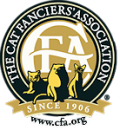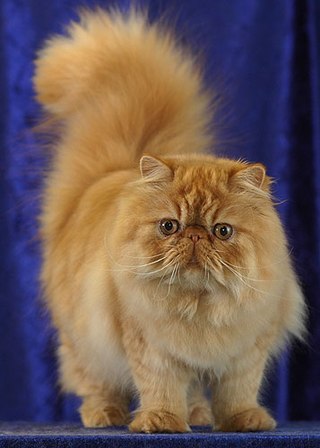
The cephalic index or cranial index is a number obtained by taking the maximum width of the head of an organism, multiplying it by 100 and then dividing it by their maximum length. The index was once used to categorize human beings in the first half of the 20th century, but today it is used to categorize dogs and cats.

A show cat is one that has been judged to be close to the physical ideal for its breed standard at a cat show. Not all pedigreed cats are show cats, many are just pets but the ones with the best conformation and personality are often shown in associations such as the CFA and TICA in the US, the GCCF in the UK or the FiFe in the rest of Europe. Uncommonly, a prize-winning pedigreed show cat can be worth thousands of dollars but most are loved pets. In order to compare examples of breeds and improve stock, cat shows are held where judges evaluate the cats according to a breed standard. Pedigreed cats are often identified with microchip implants.

The Sphynx cat also known as the Canadian Sphynx, is a breed of cat known for its lack of fur. Hairlessness in cats is a naturally occurring genetic mutation, and the Sphynx was developed through selective breeding of these animals, starting in the 1960s.

The Maine Coon is a large domesticated cat breed. It is one of the oldest natural breeds in North America. The breed originated in the U.S. state of Maine, where it is the official state cat.

The Exotic Shorthair is a breed of cat developed as a short-haired version of the Persian. The Exotic is similar to the Persian in appearance with the exception of the short dense coat.

The Norwegian Forest cat is a breed of domestic cat originating in Northern Europe. This landrace breed is adapted to a very cold climate, with a top coat of long, glossy hair and a woolly undercoat for insulation. The breed's ancestors may have been a landrace breed of short-haired cats brought to Norway about A.D. 1000 by the Vikings, who may also have brought with them long-haired cats, like those ancestral to the modern Siberian and Turkish Angora.

The Burmese cat is a breed of domestic cat, originating in Burma, believed to have its roots near the Thai-Burma border and developed in the United States and Britain.
Neutering, from the Latin neuter, is the removal of a non-human animal's reproductive organ, either all of it or a considerably large part. The male-specific term is castration, while spaying is usually reserved for female animals. Colloquially, both terms are often referred to as fixing. In male horses, castrating is referred to as gelding. An animal that has not been neutered is sometimes referred to as entire or intact.

The Cat Fanciers' Association (CFA) was established in the United States in 1906. The CFA is currently the world's largest registry of pedigreed cats. Originally headquartered in Manasquan, New Jersey, the CFA moved to Alliance, Ohio in 2010. The association's stated mission is preserving and promoting pedigreed breeds of cats while also enhancing the well-being of all cats. CFA's first licensed cat shows were held in Buffalo, New York and Detroit, Michigan in 1906. The association today has a known presence in Europe, China, and Japan along with its well-established activity in the United States and Canada.

The Ragdoll is a breed of cat with a distinct colorpoint coat and blue eyes. Its morphology is large and weighty, and it has a semi-long and silky soft coat. American breeder Ann Baker developed Ragdolls in the 1960s. They are best known for their docile, placid temperament and affectionate nature. The name 'Ragdoll' is derived from the tendency of individuals from the original breeding stock to go limp and relaxed when picked up. The breed is particularly popular in both the United Kingdom and the United States.

A luxating patella, sometimes called a trick knee, is a condition in which the patella, or kneecap, dislocates or moves out of its normal location. It can be associated with damage to the anterior cruciate ligament.

The Governing Council of the Cat Fancy (GCCF) is a cat registry, established in 1910 and the largest organisation that registers pedigree cats in the United Kingdom. It was formed from a small number of cat clubs which were registering cats at the time when the modern cat fancy was in its first stages. It is considered to be the original prototype for cat fancy registries. It is an independent body with around 150 member clubs, including specialist breed clubs and area clubs covering particular regions. The GCCF became an incorporated company on 5 November 2010. It licenses cat shows put on by its affiliated clubs with about 135 shows per year. Pedigree cats shown at these shows can gain the titles Champion, Grand Champion, Imperial Grand Champion and Olympian. The latter having three levels, Bronze, Silver and Gold. The word Champion is replaced by Premier for neutered cats, and Master Cat for cats competing in household pets. The showing of non-pedigree cats and Pedigree Pets is also popular at GCCF shows.
Epilepsy in animals is a group of neurological disorders characterized by seizures, caused by uncontrolled, abnormal bursts of electrical activity in the brain. They can start and stop very abruptly and last any amount of time from a few seconds to a few minutes. Canine epilepsy is often genetic but epilepsy in cats and other pets is rarer, likely because there is no hereditary component to epilepsy in these animals.
Growling is a low, guttural vocalization produced by animals as an aggressive warning but can also be found in other contexts such as playful behaviors or mating. Different animals will use growling in specific contexts as a form of communication. In humans, low or dull rumbling noises may also be emitted when they are discontent with something or they are angry, although this human sound is often termed "groaning".

Vaccination of dogs is the practice of animal vaccination applied to dogs. Programs in this field have contributed both to the health of dogs and to the public health. In countries where routine rabies vaccination of dogs is practiced, for example, rabies in humans is reduced to a very rare event.

The health of domestic cats is a well studied area in veterinary medicine.

The Canadian Cat Association is a non-profit organization in Canada whose mission is to promote the welfare of all cats in Canada, maintain a registry of pedigreed cats in Canada, and further the improvement of all breeds of cats in Canada. CCA-AFC is Canada's only globally-recognized national cat registry, with its pedigrees and registrations accepted by major global associations such as the Cat Fanciers' Association, The International Cat Association, and Fédération Internationale Féline. To date, CCA-AFC has registered over 190,000 cats.

The Abyssinian is a breed of domestic short-haired cat with a distinctive "ticked" tabby coat, in which individual hairs are banded with different colors. They are also known simply as Abys.

The Persian cat, also known as the Persian Longhair, is a long-haired breed of cat characterised by a round face and short muzzle. The first documented ancestors of Persian cats might have been imported into Italy from Khorasan as early as around 1620, however, this has not been proven. Instead, there is stronger evidence for a longhaired cat breed being exported from Afghanistan and Iran from the 19th century onwards. Widely recognised by the North-West European cat fancy since the 19th century, and after World War II by breeders from North America, Australia and New Zealand. Some cat fancier organisations' breed standards subsume the Himalayan and Exotic Shorthair as variants of this breed, while others generally treat them as separate breeds.

Human interaction with cats relates to the hundreds of millions of cats that are kept as pets around the world. The inter-relationship involves companionship, communication and caregiving. Dating back thousands of years, cats were originally domesticated for their ability to control pests and later became valued companions. Cats communicate through vocalizations, body language and behaviors, forming strong bonds with their human owners. Owners provide the food, shelter, and medical care, while play and enrichment activities stimulate their physical and mental well-being. Despite their independent nature, cats enjoy human company and require understanding of their unique behaviours. Positive reinforcement training can shape desired behaviours, fostering a harmonious relationship between humans and their feline companions, built on mutual respect and affection.




















